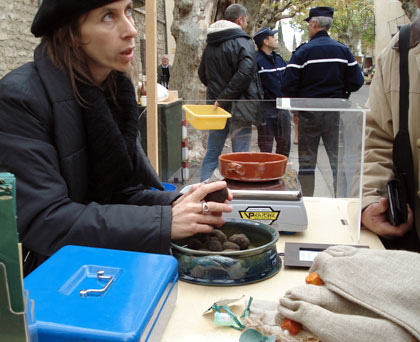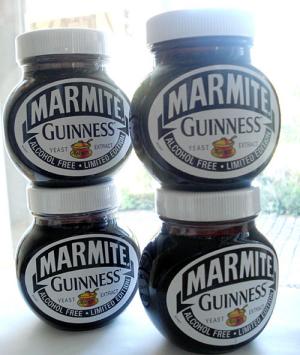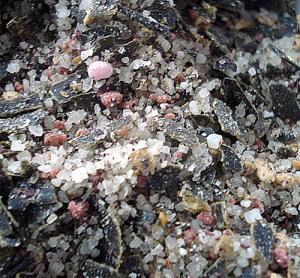
Originally published on December 9, 2006: We won't be able to go to Provence this winter because of work, but I still dream about it, and plan for the next trip hopefully in the spring. Here is an article from our trip last year, about a wonderful truffle market in northern Provence. I hope you enjoy it!
The lady vendor with the intense blue gaze and the black beret on her head looks a little like a French Resistance worker from an old movie. She gestures with her hands as she talks, occasionally taking one of her wares gently in her slender fingers. Around her a curious group of people gathers, looking and sniffing intently, asking questions. I slowly inch my way to the front and look into the bowl, then up to her face, my meager French deserting me. She smile and tells me to pick one.
Filed under:
food travel ingredients mushrooms winter provence france
I was recently sent a book about Japanese cooking for review. I wasn't too impressed by the book for a variety of reasons, but one thing that really bothered me was that it used dashi stock powder for practically every recipe. (What made it worse is that the book's title proclaimed the recipes therein to be "Healthy".)
Dashi stock powder is akin to soup stock cubes in Western cooking. Like soup stock cubes, they are a very convenient way to add a concentrated dose of umami to a dish. I do have a box of the stuff in my kitchen which I use on occasion.
But keep in mind that dashi stock powder contains quite a lot of MSG. The good or bad of MSG may be a debatable subject, but when it comes to food additives I always like to be on the cautious side. Besides, with the right ingredients making dashi stock from real ingredients, even a vegan version, doesn't take that much time - and tastes a whole lot better too. This is different from the time and effort, not to mention the mess, needed to make a good chicken stock, for example. On my list of Japanese pantry essentials, I have put MSG or Ajinomoto as something that's optional, and I regard dashi powder in the same light.
In Japan, more and more households are turning away from dashi stock powder for health reasons, especially in families with small children. I don't see any reason for people new to Japanese cooking to start out on the wrong leg by relying on an iffy convenience product.
Filed under:
japanese ingredients

Back in February I reported on the new limited edition Guinness Marmite. Since then, the salty yeast spread connoisseur in me yearned to taste this mysterious combination. Parts of me panicked at the thought of it selling out before I had a chance at it.
Enter my friend Mimi to the rescue. She kindly procured not one, but four, yes 4, 250 gram jars of Guinness Marmite for me, which arrived in the mail today. My first reaction: "ZOMG, a kilo of Marmite!" (That's about 2.2 lb for the metrically challenged.)
Calming down, I proceeded to inspect it in detail.
Filed under:
ingredients offbeat uk marmite

If you browse the aisles of a Japanese grocery, you may run across various instant tsukemono mixes. These come either in liquid or dry form. The dry granules in particular are very handy to have around, and they can make sokuseki zuke in a hurry. However, they usually contain MSG, preservatives and such.
Scouring around the Japanese parts of the interweb, I came across several pages that had recipes for a homemade instant tsukemono mixes, such as this one. They all used MSG or dashi stock granules though, and I wanted to come up with a mixture that was made up 100% of natural ingredients.
After some tinkering around and almost ruining the motor of my food processor, here's the mixture I came up with. To up the umami quotient it has a full 100 grams of finely chopped konbu seaweed in it. It also has some interesting very Japanese ingredients in it such as dried yuzu peel and yukari, dried powdered red shiso leaves.
Filed under:
japanese ingredients vegetarian vegan tsukemono
Seamaiden, who has a lovely gluten-free blog called Book of Yum, asked in the comments here whether Ajinomoto is gluten-free. Since I know that a lot of people become interested in rice-centric Asian cuisines, including Japanese, because of the wide variety of wheat-free dishes, I thought I'd post some of my findings here about Ajinomoto and dashi stock granules rather than bury them in the comments.
Monosodium glutamate or MSG is a concentrated and manufactured form of umami. It is a flavor enhancer with a lot of controversy. I won't get into that at the moment, since reactions to MSG really vary widely depending on the individual. The reality is that MSG is present in many manufactured food products.
Filed under:
japanese ingredients health gluten-free
A lot of Japanese dishes are quite subtly flavored to start with, and are eaten dipped in a simple soy sauce based dipping sauce. You're probably familiar already with the wasabi + soy sauce combination used for most kinds of sashimi and sushi, but there are a few others. Which sauce goes with which dish really seems to depend as much on tradition as anything, though certain combinations just fit better than others. The ratio of flavoring to soy sauce is a matter of personal taste in most cases.
Whenever using a dipping sauce, try not to dunk whatever you are eating into it. The common sushi eating mistake made is to dunk the rice side into soy sauce - this not only makes the rice grains go all over the place, often down your front, but absorbs way too much soy sauce. Turn the sushi over and dip the fish just a bit instead. (I tend to think that this rice-dunking is why a lot of the finer sushi restaurants nowadays serve their sushi pre-seasoned, needing no dipping.)
Here are the most commonly used dipping sauce combinations:
Filed under:
basics japanese ingredients

Wow, look at the gorgeous black and white special edition Guinness Marmite jar! Limited to a run of 300,000 jars, this special blend of Guinness and Marmite is on sale in the U.K. right now. I'm not too sure how different it would be in taste from regular Marmite, which is after all a yeast spread. I'm speculating it might taste like the slightly beer-y Cenovis. Now how to get my hands on one... (link via Coolest Gadgets and The Guinness Blog - yes, Guinness has a blog. The portal is a bugger...just say you are from England, and old enough.)
Filed under:
ingredients offbeat uk
As I wrote in the Beef Curry recipe, I don't make my own curry powder. Lomo asked in the comments about the "secret" 15 to 20 spices that make up curry powder. After poking around a bit on Japanese web sites, I came up with this page that describes what goes into S & B curry powders, the most popular brand by far in Japan. It's an official S & B page, so should be accurate, though as you can see the percentage given have a pretty wide range. I guess it's because the actual formulas are 'secret'. In any case it gives a starting point for any experimentation I think.
I've also included a recipe for making garam masala. Note that I make no claims whatsoever that these are authentic mixes for Indian or other curries, but I'm talking here about Japanese curry.
Filed under:
japanese ingredients curry spices

The BBC News web site's Magazine section has an article today about the history of how turkey became fast food. While it's about turkey production in the UK, it's probably applicable to any nation that has large scale consumption, and production, of turkey meat.
Filed under:
ingredients ethics turkey
Pages